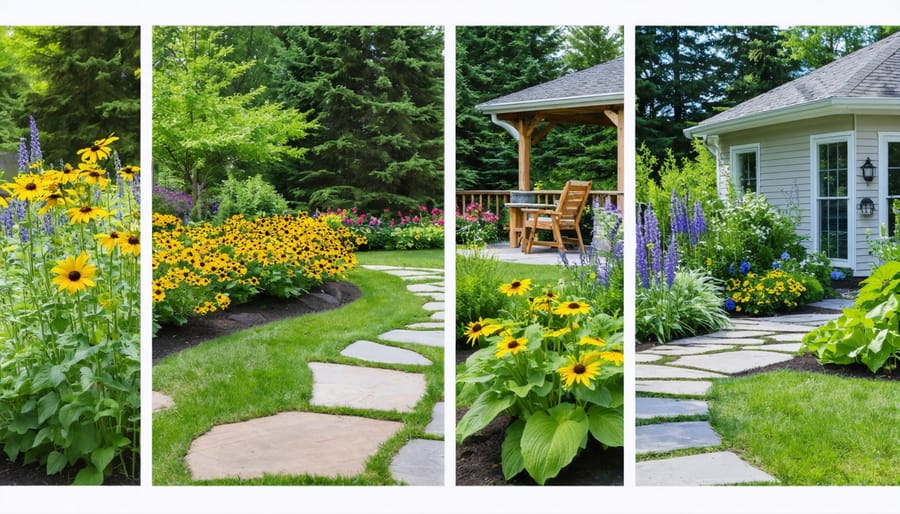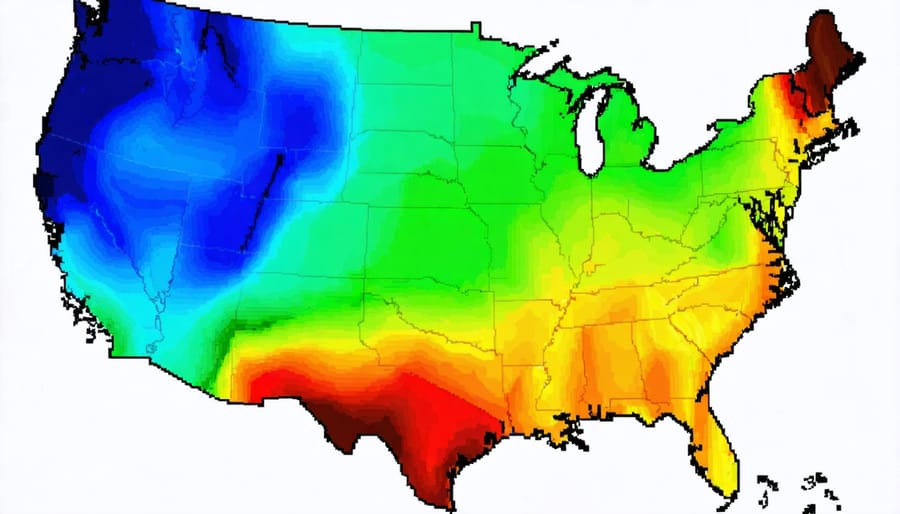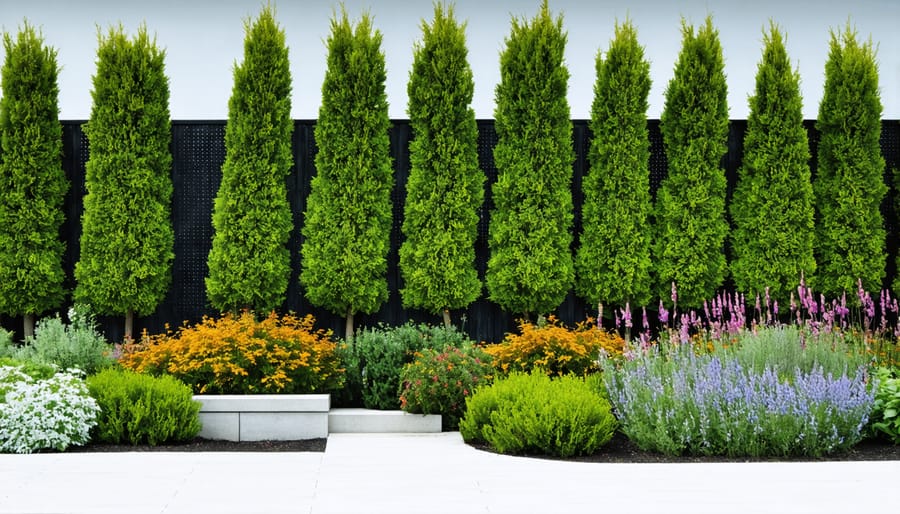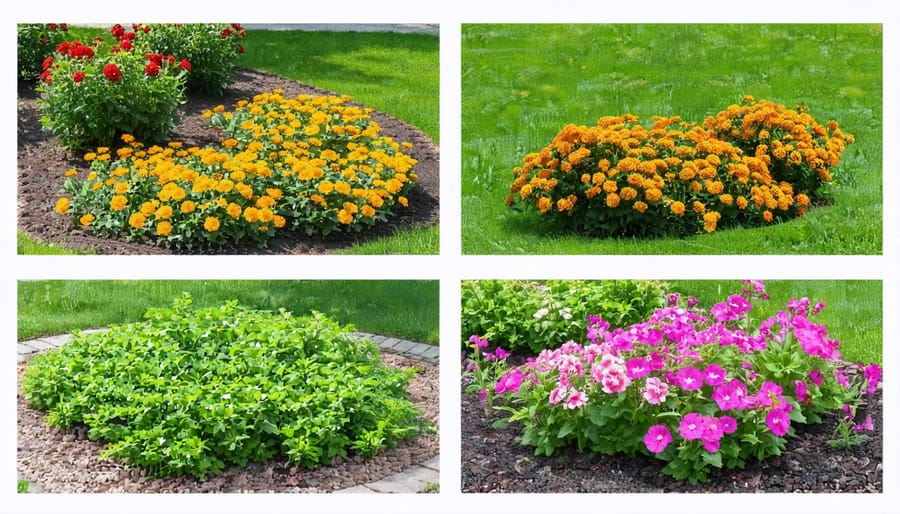Transform Your Zone 6 Garden Into a Year-Round Paradise (Even in Harsh Weather)

Transform your Zone 6 landscape into a four-season masterpiece by embracing the unique challenges and opportunities of this diverse growing region. With winter temperatures dipping to -10°F and hot summers reaching well into the 90s, Zone 6 demands thoughtful design strategies that balance beauty with resilience. Smart landscaping in this zone means selecting hardy perennials like Black-Eyed Susans and Russian Sage that thrive in both summer heat and winter cold, while incorporating structural elements like stone pathways and pergolas that provide year-round interest. Create distinct outdoor rooms using strategic plantings of native trees and shrubs, which not only withstand Zone 6’s temperature swings but also provide essential windbreaks and shade during extreme weather. By focusing on these climate-specific design principles, your landscape can flourish through every season while requiring minimal maintenance and providing maximum enjoyment.
Understanding Zone 6 Climate Challenges

Temperature Range Planning
Zone 6’s temperature range presents unique challenges and opportunities for landscape design. With winter temperatures dipping between -10°F and 0°F and summers reaching into the 90s, careful planning is essential for a successful garden. To effectively manage these conditions, it’s important to monitor temperature fluctuations throughout your landscape.
Create microclimates by using structures like walls, fences, and storage buildings to block harsh winter winds and provide shade during intense summer heat. South-facing areas tend to be warmer and are perfect for heat-loving plants, while north-facing spots offer protection for shade-tolerant species.
Consider incorporating mulch to insulate plant roots during temperature extremes. A 2-3 inch layer helps maintain soil moisture and protects plants from winter freeze-thaw cycles. Adding thermal mass elements like stone pathways or water features can help moderate temperature swings by absorbing heat during the day and releasing it slowly at night.
When selecting plants, choose varieties that can handle both temperature extremes. Native species are particularly well-adapted to Zone 6’s climate variations and require less maintenance to thrive year-round.
Growing Season Strategy
Zone 6’s growing season typically spans from mid-March to mid-November, offering gardeners about 180 frost-free days to work with. Making the most of this window requires careful planning and strategic timing. Start your growing season by preparing beds and soil as soon as the ground thaws in early spring. Take advantage of cool-season vegetables like peas, lettuce, and spinach by planting them in March or early April.
For summer-blooming perennials and annuals, wait until after the last frost date, usually around mid-April to early May. This is also the ideal time to establish warm-season vegetables and tender ornamentals. Consider implementing succession planting for continuous harvests and blooms throughout the season.
As autumn approaches, focus on fall-friendly plants like mums, asters, and cool-season vegetables for a second growing period. Plant spring bulbs in October before the ground freezes. To extend your growing season, use techniques like cold frames, row covers, or portable greenhouses, which can add several weeks to both ends of your growing calendar. Remember to allow adequate time for plants to establish strong root systems before winter sets in.
Strategic Layout Design
Sun Mapping Your Space
Before diving into plant selection or hardscape placement, understanding your yard’s sun exposure patterns is crucial for successful Zone 6 landscape design. Start by observing your space throughout different seasons and times of day, noting how sunlight moves across your property.
Create a simple sun map by dividing your yard into three main exposure categories: full sun (6+ hours of direct sunlight), partial sun/shade (3-6 hours of direct sunlight), and full shade (less than 3 hours of direct sunlight). Consider seasonal changes, as deciduous trees will cast different shadows throughout the year.
Pro tip: Use wooden stakes or garden markers to track shadow patterns, especially in areas where you plan to install strategic outdoor lighting or place storage structures. This mapping will help you make informed decisions about plant placement and ensure your shed or storage solutions receive appropriate light exposure.
Remember that south-facing areas typically receive the most sun, while north-facing spaces tend to be shadier. East-facing locations get gentle morning sun, and west-facing areas experience intense afternoon heat. Use this knowledge to create micro-climates within your landscape, maximizing the potential of each space while protecting sensitive plants and outdoor storage elements from harsh conditions.
Wind Break Integration
In Zone 6, where winter winds can be particularly harsh, incorporating windbreaks into your landscape design is essential for creating comfortable outdoor spaces and protecting your plants. Strategic placement of both natural and structural windbreaks can reduce heating costs, prevent winter damage, and create cozy micro-climates throughout your yard.
Consider planting evergreen trees and shrubs in a staggered pattern along the north and northwest sides of your property, where winter winds typically hit hardest. Dense conifers like Norway Spruce or Eastern White Pine work excellently as living windbreaks, while also providing year-round privacy and wildlife habitat.
For immediate protection, combine both living and structural elements. Fencing, particularly solid panels or closely-spaced lattice designs, can offer instant wind protection while your natural windbreak grows. Position these barriers about 50 feet from the areas you want to protect for optimal effectiveness.
Don’t forget to create smaller wind barriers around specific garden areas or patios. Use decorative screens, climbing plants on trellises, or mixed shrub borders to break up wind patterns while adding visual interest to your landscape. These smaller windbreaks can also help extend your growing season by protecting vegetable gardens and tender perennials from damaging gusts.
By thoughtfully integrating windbreaks into your Zone 6 landscape, you’ll create more enjoyable outdoor spaces while protecting your investment in plants and outdoor living areas.

Plant Selection and Placement
Hardy Perennial Choices
Zone 6 gardens come alive with a stunning variety of hardy perennials that return year after year, adding reliable beauty to your landscape. Black-eyed Susans offer cheerful yellow blooms from summer through fall, while Purple Coneflowers attract butterflies and provide winter interest with their distinctive seed heads. For shaded areas, Hostas prove invaluable with their varied leaf patterns and low-maintenance nature.
Consider incorporating Daylilies, which offer weeks of colorful blooms and help prevent soil erosion on slopes. Russian Sage adds height and airy purple spikes that complement other perennials while being incredibly drought-tolerant. If you want to create an edible landscape, try incorporating hardy herbs like Lavender and Sage, which provide both beauty and functionality.
Blanket Flower (Gaillardia) brings long-lasting red and yellow blooms that thrive in full sun, while Coral Bells offer colorful foliage that brightens partially shaded spots. For fall interest, Japanese Anemones provide elegant white or pink flowers when other plants are winding down. Don’t forget Sedum ‘Autumn Joy,’ which transitions from pink to copper throughout the season and stands up beautifully to Zone 6’s winter conditions.
These perennials not only withstand Zone 6’s temperature fluctuations but also create a foundation for your landscape that grows more beautiful with each passing year.
Four-Season Interest
Creating a landscape that captivates throughout the year requires thoughtful planning in Zone 6. Start with evergreen foundations like boxwood and juniper to maintain structure during winter months. Layer in early spring bloomers such as witch hazel and hellebores, which provide welcome color when most gardens are still dormant.
Summer brings endless possibilities, but choose perennials that offer extended blooming periods. Combine classics like black-eyed susans and purple coneflowers with ornamental grasses that will continue providing interest well into fall. Include plants with interesting foliage, such as Japanese maples or hostas, which maintain visual appeal even when not flowering.
For autumn drama, incorporate trees and shrubs known for spectacular fall color. Burning bush, sugar maple, and oakleaf hydrangea offer stunning red and purple hues. Don’t forget late-blooming perennials like asters and sedum ‘Autumn Joy’ to keep the garden vibrant through the season’s end.
Winter interest comes from plants with distinctive bark (river birch), colorful berries (winterberry holly), and interesting architectural forms (ornamental grasses left standing). Strategic lighting can highlight these features during the darker months, while hardscape elements like decorative walls or artistic trellises provide year-round structure.
Consider placing these elements where they’re visible from indoor living spaces to enjoy your garden’s changing character throughout the year.

Storage and Maintenance Solutions
Tool Storage Integration
In Zone 6, where seasonal changes demand thoughtful storage solutions, integrating a garden shed or storage area into your landscape design isn’t just practical—it’s essential. The key is selecting storage options that not only protect your tools and equipment from harsh weather conditions but also enhance your garden’s visual appeal.
Consider positioning your shed where it naturally flows with your landscape design. A well-placed shed can serve as a focal point, especially when surrounded by strategic plantings like ornamental grasses or flowering shrubs that soften its edges. For maximum functionality, ensure your shed is easily accessible from main garden areas while providing protection from prevailing winds and extreme weather.
When choosing materials, opt for weather-resistant options that complement your home’s architecture. Cedar, vinyl, or composite materials offer excellent durability in Zone 6’s climate while maintaining aesthetic appeal. Adding architectural elements like window boxes, decorative trim, or climbing trellises can transform a basic storage structure into a charming garden feature.
Smart organization within your shed is crucial for year-round functionality. Install adjustable shelving, tool racks, and pegboards to maximize vertical space. Consider incorporating a potting bench near a window for early spring seed starting. For smaller gardens, explore space-saving solutions like wall-mounted tool organizers or corner storage units.
Remember to create a weather-resistant pathway to your storage area, ensuring easy access during wet conditions. Permeable materials like gravel or stepping stones work well while adding to the overall design. Proper lighting along the path enhances safety and extends usage hours during shorter winter days.
Seasonal Maintenance Zones
In Zone 6, dedicating specific areas for seasonal maintenance is crucial for garden success. Creating efficient seasonal storage solutions helps protect your plants and tools while maintaining landscape beauty throughout the year.
Start by establishing a composting zone in a partially shaded area, ideally near your vegetable garden or flower beds. This location should be easily accessible for adding materials and collecting finished compost. Consider installing multiple bins to rotate materials effectively and maintain a continuous supply of nutrient-rich soil amendment.
For plant storage, designate a sheltered area where you can overwinter sensitive perennials and store seasonal containers. A north-facing wall with wind protection works well for this purpose. Include sturdy shelving or raised platforms to keep plants off the ground and prevent frost damage. This space should have good air circulation while protecting plants from harsh winter elements.
Create a winter protection station where you store supplies like burlap wraps, frost blankets, and stakes. Having these materials organized and ready to use makes it easier to respond quickly when frost threatens. Consider adding a small potting area nearby for early spring seed starting and container preparation.
Don’t forget to incorporate a tool-cleaning station near your storage area. This helps maintain equipment properly and extends its life. Include a water source if possible, and consider adding a small workbench for basic tool maintenance and repair.
Make these zones blend naturally into your landscape by using attractive fencing, screens, or strategic placement behind evergreen shrubs. This approach maintains your garden’s aesthetic appeal while providing essential maintenance functionality.
Creating a stunning Zone 6 landscape is an achievable goal with the right planning and knowledge. By understanding your climate’s unique characteristics and choosing appropriate plants, hardscaping elements, and storage solutions, you can transform your outdoor space into a beautiful and functional retreat that thrives throughout all four seasons.
Remember that successful Zone 6 landscaping is all about balance – combining cold-hardy perennials with seasonal showstoppers, incorporating practical storage solutions that complement your design, and creating spaces that serve both aesthetic and functional purposes. The key is to work with your environment rather than against it, selecting plants and materials that can handle both winter freezes and summer heat.
Don’t be afraid to start small and expand your landscape gradually. Begin with a solid foundation of reliable plants and basic hardscaping, then add layers of interest over time. Consider how your needs might change through the seasons and plan accordingly, ensuring your outdoor space remains useful and beautiful year-round.
Whether you’re starting from scratch or renovating an existing landscape, the possibilities for Zone 6 gardens are endless. With proper planning, appropriate plant selection, and thoughtful design choices, you can create an outdoor oasis that not only survives but thrives in your climate zone while providing years of enjoyment for you and your family.

